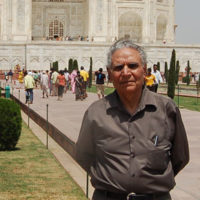Nine major trade union federations of India demonstrated together last month on five essential issues that affect a vast majority of Indian people. On March 5, the union federations, representing 50 million members, marched and demanded price controls on essential commodities,and food grains, government steps against job loss and economic crisis, social security fund for unorganized workers, implementation of labor laws and an end to divestment of the public sector. The nine union federation leaders marched shoulder to shoulder in a rare show of trade union unity.
In India, like many countries of Asia and Europe, unions are affiliated to political parties. The largest union federation in India is the National Trade Union Congress, which is affiliated to the ruling Indian Congress Party. They claim a membership of 15 million.
A surprise move was the BMS labor federation, associated with the extreme-right, Hindu party called the BJP, joined the protests. They claim a membership equal to the National Trade Union Congress.
The two Communist-affiliated federations, which were in the forefront of calling for the demonstration, have a total membership of 17 million. The Communist Party of India’s union federation, AITUC (All India Trade Union Center) is the oldest labor federation in the country, has a membership of 11 million. The Communist Party of India-Marxist, which split from the CPI in the 1960s, is associated with the 6-million-member Center of Indian Trade Unions. In addition to these four, there were five other union federations, called centers in India.
Numerous observers found the unity of the unions “heart warming” and a promise for the future. The workers showed a marvelous strength in struggle, observers said. The united national action was simultaneously reproduced in almost every state, district and county headquarters. For example, in the state of Tamil Nadu, an estimated 100,000 members from 179 locales demonstrated and courted arrest.
This joint action in India is a new phenomenon, born out of life experiences of Indian working class. The economic crisis affecting Indian workers and families is marked by massive privatization, a one-way opening of Indian markets to global private capital investment and unbearable price rise of basic food commodities.
The INTUC chief met the prime minister of India before the massive demonstration. But nothing was done to relieve the pressure on workers and their families. Therefore the INTUC chief said that the struggle will continue on March 5 and beyond. There were arrests on March 5, but the government maintained cool and the arrested were released soon after detentions.
The Indian corporate and government world is watchful and tense after such cross-party unity among trade unions leaders and the rank and file. A massive restructuring is happening to the Indian economy. A large section of public sector employees are affected by a “contractor system” being introduced and practiced to augment profits and avoiding government responsibilities. Many employees are being declared part-time wagers to avoid benefit payments.
The government also seems to be rushing efforts to increase GDP. They want to prove that the corporate sector can do beat out the competition, especially with next door neighbors like China. So the government offers concession after concession to corporations, and stimulus packages are doled out with hopes that some benefits might trickle down to people.
The unions are asking the government to link the corporate stimulus to retaining and increasing jobs. Otherwise you are only enabling the non govt employers to fatten themselves at the cost of public exchequer, they say.
This struggle enables the nine trade union centers to do a review of their respective strength and weakness in their fields. The reality is two-thirds of the workforce is yet to be enrolled in unions. If the nine centers decide in their next meeting to try to approach the unorganised work force, the political importance of the class will gain immense power in extent and intensity.
Photo: Union members and supporters from Tamil Nadu. Teresa Albano/PW









